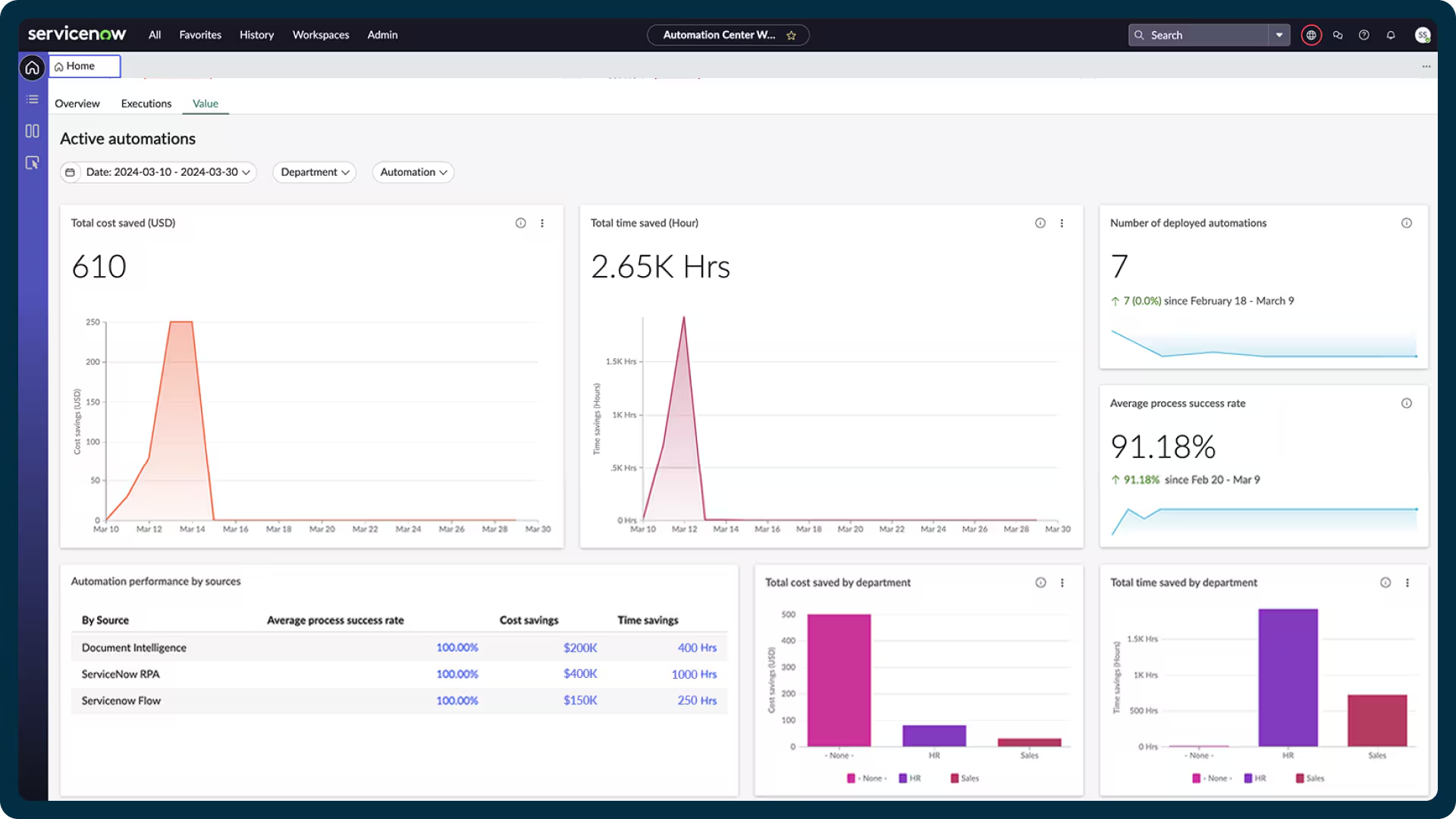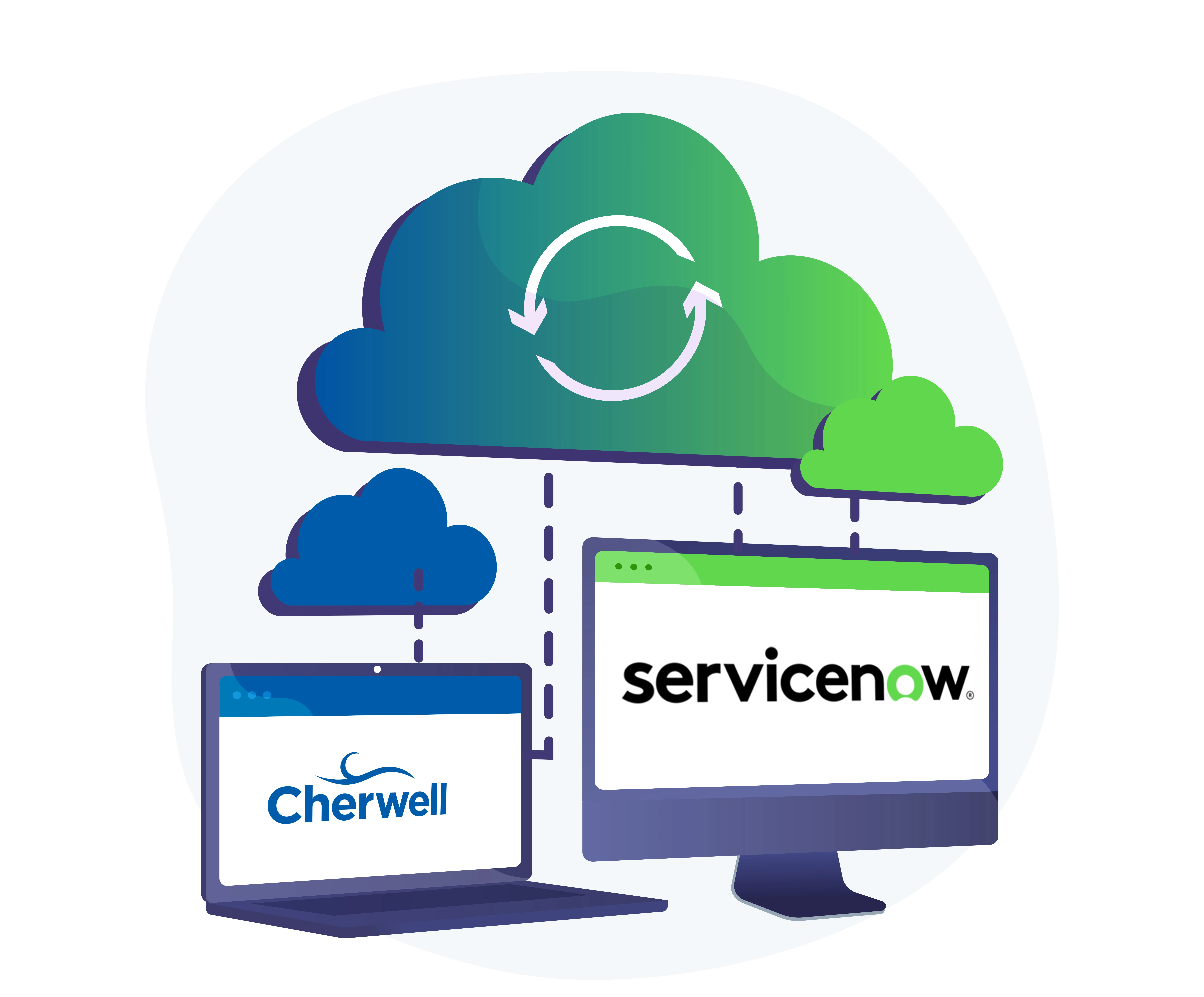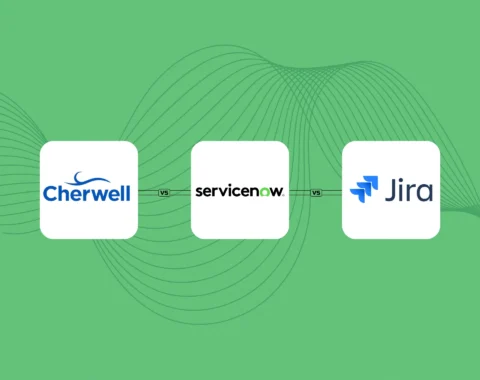Intelligent automation, what was once seen as an ‘add-on’, is now an absolute necessity. It enables faster decisions, eliminates manual tasks, and ensures consistent, high-quality service across every department. Aelum helps you utilize the full potential of ServiceNow Automation solutions to streamline workflows, unify systems, and build smarter processes. From IT to customer service, we design intelligent automation solutions that adapt to your business and scale with your growth so your people can focus on what truly matters: innovation, speed, and customer satisfaction.
Achieve enterprise-wide business transformation with ServiceNow & Aelum

Redefining Enterprise Efficiency with ServiceNow Automation Solutions

Comprehensive ServiceNow Automation Capabilities
Workflow Automation
Streamline task flows and approvals with custom workflows triggered by real-time conditions or events. Perfect for accelerating internal operations and approvals.
AI Automation
Leverage machine learning and natural language processing for smarter, faster decisions. Think chatbots, predictive analytics, and recommendation engines—all powered by ServiceNow’s intelligent algorithms.
IT Operations Automation
Automate critical IT operations like server provisioning, patching, and configuration management through ServiceNow’s ITOM suite—ensuring uptime and resilience.
Business Process Automation (BPA)
Orchestrate end-to-end processes across multiple systems. From data collection to analysis, ServiceNow’s graphical BPA tools deliver true enterprise-wide automation.
Service Desk Automation
Improve response times and efficiency by automating ticket creation, routing, and resolution. ServiceNow Service Desk brings clarity and speed to your IT support.
Test Automation
Ensure reliability with automated unit, integration, and performance testing. Deploy confidently and detect issues before they reach production.
Security Automation
Strengthen your cybersecurity posture with automated vulnerability scans, threat detection, and incident response, powered by ServiceNow’s Security Operations (SecOps) module.
IT Infrastructure Automation
Utilize Infrastructure as Code (IaC) and configuration management tools to automate deployments and manage infrastructure with speed and accuracy.
Robotic Process Automation (RPA)
Let software bots handle repetitive, rules-based tasks like data entry and file processing, freeing up human talent for strategic initiatives.
Marketing Automation
Automate campaign execution across email, social, and web. Integrate your CRM and CMS to drive smarter, personalized marketing at scale.
Workflow Automation

Streamline task flows and approvals with custom workflows triggered by real-time conditions or events. Perfect for accelerating internal operations and approvals.
AI Automation

Leverage machine learning and natural language processing for smarter, faster decisions. Think chatbots, predictive analytics, and recommendation engines—all powered by ServiceNow’s intelligent algorithms.
IT Operations Automation

Automate critical IT operations like server provisioning, patching, and configuration management through ServiceNow’s ITOM suite—ensuring uptime and resilience.
Business Process Automation (BPA)

Orchestrate end-to-end processes across multiple systems. From data collection to analysis, ServiceNow’s graphical BPA tools deliver true enterprise-wide automation.
Service Desk Automation

Improve response times and efficiency by automating ticket creation, routing, and resolution. ServiceNow Service Desk brings clarity and speed to your IT support.
Test Automation

Ensure reliability with automated unit, integration, and performance testing. Deploy confidently and detect issues before they reach production.
Security Automation

Strengthen your cybersecurity posture with automated vulnerability scans, threat detection, and incident response, powered by ServiceNow’s Security Operations (SecOps) module.
IT Infrastructure Automation

Utilize Infrastructure as Code (IaC) and configuration management tools to automate deployments and manage infrastructure with speed and accuracy.
Robotic Process Automation (RPA)

Let software bots handle repetitive, rules-based tasks like data entry and file processing, freeing up human talent for strategic initiatives.
Marketing Automation

Automate campaign execution across email, social, and web. Integrate your CRM and CMS to drive smarter, personalized marketing at scale.
Our Services

Automation Consultation
We assess your current environment, identify automation opportunities, and design a phased plan aligned with your business goals.

Automation Implementation
We configure and integrate ServiceNow modules tailored to your needs ITSM, ITOM, HRSD, CSM, CRM, and more ensuring seamless platform adoption.

Build Custom ServiceNow AI Agents
We build intelligent, data-driven workflows and AI models that streamline operations across sales, service, IT, and security.

We assess your current environment, identify automation opportunities, and design a phased plan aligned with your business goals.

We configure and integrate ServiceNow modules tailored to your needs—ITSM, ITOM, HRSD, CSM, CRM, and more—ensuring seamless platform adoption.

We build intelligent, data-driven workflows and AI models that streamline operations across sales, service, IT, and security.
We Serve Across Industries
Aelum helps enterprises drive impact and measurable productivity with ServiceNow Automation.
Healthcare
Automate administrative tasks like appointment scheduling and patient registration, allowing healthcare professionals to focus on patient care.
Our Approach for ServiceNow Automation Solutions
Identify Business Processes
The first step in ServiceNow automation discovery is to identify the business processes that are most critical to the organization. It can include processes such as incident management, change management, and service request management.
Identify Stakeholders
When conducting ServiceNow automation discovery, it is important to identify the stakeholders impacted by the automation. By involving stakeholders in the automation discovery process, you can ensure that their needs and requirements are taken into account.
Analyze Process Flow
Once the critical business processes have been identified, the next step is to analyze the process flow to identify areas where automation can be applied. It can include tasks that are repetitive, time-consuming, or prone to errors.
Gather Data
In order to identify automation areas, it is important to gather data on existing processes and tasks. It can include data on task completion times, error rates, and other KPIs. By analyzing this data, you can identify areas where automation can be applied to improve efficiency.
Identify Automation Opportunities
In order to identify automation areas, it is important to gather data on existing processes and tasks. It can include data on task completion times, error rates, and other KPIs. By analyzing this data, you can identify areas where automation can be applied to improve efficiency.
Prioritize Automation
When developing an automation roadmap, it is important to prioritize the opportunities based on their impact and feasibility. It includes cost-saving potential, the effort level required to implement automation, & the strategic importance of the process or task.
Evaluate Automation Feasibility
After identifying automation opportunities, the next step is to evaluate the feasibility of implementing it. It can include factors such as process complexity, data, systems availability, and the cost-benefit analysis of implementing automation.
Consider Integration
ServiceNow is often just one part of an organization’s IT ecosystem. When conducting automation discovery, it is important to consider how ServiceNow can be integrated with other systems or tools, like integrations with IT monitoring tools, HR systems, and other business applications.
Develop Automation Roadmap
After evaluating the feasibility of implementing the automation, the next step is to develop an automation roadmap. It should include a prioritized list of automation opportunities, a timeline for implementation, and a plan for testing and deployment.
Plan for Change Management
Implementing automation can significantly impact an organization’s processes and workflows. When developing an automation roadmap, it is important to plan for change management. It can include communication and training plans to help stakeholders.
Key Products and Apps of ServiceNow Automation
Core Products and Applications of ServiceNow Automation Enterprises Can Use

ServiceNow Flow Designer
A low-code workflow automation tool enabling users to automate processes and tasks without requiring extensive coding. It provides a drag-and-drop interface for building workflows, making it easy for non-technical users to create automated processes.

ServiceNow Performance Analytics
A tool providing real-time visibility into KPIs & metrics for IT services and business processes. It enables organizations to track and analyze their performance against predefined goals, identify areas for improvement, and take proactive measures to optimize their operations.

ServiceNow IntegrationHub
An integration platform that enables organizations to connect ServiceNow with other applications and systems. It provides pre-built integrations for popular applications such as Microsoft Office 365, Slack, and JIRA and the ability to build custom integrations.

ServiceNow Discovery
A tool that automates the discovery and mapping of IT assets and dependencies across an organization’s infrastructure. It provides real-time visibility into the IT environment, enabling organizations to identify potential issues & take proactive measures to prevent downtime.

ServiceNow Virtual Agent
A chatbot platform enabling organizations to provide self-service support to users. It uses natural language processing to understand user requests and provide automated responses, reducing the need for manual intervention.

ServiceNow Service Mapping
A tool that automatically maps the relationships between IT services, infrastructure, and apps. It provides a comprehensive view of an organization’s IT environment, enabling IT teams to quickly identify the root cause of issues and resolve them before they impact business operations.

ServiceNow Orchestration
An automation engine enabling organizations to automate complex IT and business processes. It provides pre-built workflows for common tasks such as server provisioning, application deployment, and database management, as well as the ability to build custom workflows.

ServiceNow Security Operations
A tool that automates detecting and responding to security incidents. It provides real-time threat intelligence, automated workflows, and integrations with other security tools, enabling organizations to identify and respond to security threats quickly.

ServiceNow Service Catalog
A self-service portal empowering users to request IT services and track their progress. It can be customized to reflect an organization’s unique service offerings and can include automated workflows for tasks such as ticket creation and approval.

ServiceNow Governance, Risk, and Compliance
A self-service portal empowering users to request IT services and track their progress. It can be customized to reflect an organization’s unique service offerings and can include automated workflows for tasks such as ticket creation and approval.
Our Clients
























Case Studies
ServiceNow AI seamlessly integrates into every facet of your enterprise, transforming operations across departments.
Frequently Asked Questions
Workflow automation in ServiceNow is a key feature that allows users to design, configure, and execute automated processes to streamline various business functions. Here are some of the key features and benefits of ServiceNow workflow automation:
- Drag-and-drop workflow designer: ServiceNow workflow designer allows users to design and customize workflows using a drag-and-drop interface easily. It makes it easy for non-technical users to create and modify workflows.
- Automated task management: ServiceNow workflow automation allows users to automate various tasks, such as ticket routing, approvals, and escalations. It reduces the need for manual intervention and ensures that tasks are completed efficiently.
- Integration with other systems: ServiceNow workflow automation can integrate with other systems, such as email, chat, and monitoring tools. It allows users to create end-to-end workflows that span multiple systems.
- Real-time tracking and reporting: ServiceNow workflow automation provides real-time tracking and reporting capabilities. It allows users to monitor the progress of workflows and identify bottlenecks and issues.
- Improved efficiency and productivity: ServiceNow workflow automation helps organizations to streamline their business processes and reduce manual effort. It improves efficiency and productivity while also reducing errors and delays.
Creating a business case for automation is an important step in justifying the investment in automation initiatives. Here are some key steps to follow when creating a business case for automation:
- Step 1: Identify the business problem the automation initiative is meant to solve. It could be anything from reducing manual effort and errors to improving process efficiency and reducing costs.
- Step 2: Identify the benefits of implementing the automation initiative. It could include increased productivity, improved quality, reduced costs, or improved customer satisfaction.
- Step 3: Estimate the costs associated with implementing the automation initiative. It could include software licenses, hardware, development resources, and ongoing maintenance costs.
- Step 4: Calculate the ROI for the automation initiative by comparing the estimated benefits to the estimated costs. It will help to determine whether the investment is likely to be profitable.
- Step 5: Consider the risks and challenges associated with the automation initiative, such as implementation risks, adoption challenges, and potential disruption to existing processes.
- Step 6: Present the business case to key stakeholders, including executives, department heads, and other decision-makers. Use clear and concise language to explain the automation initiative’s benefits, costs, and ROI.
Overall, creating a business case for automation requires careful consideration of the specific business problem, benefits, costs, ROI, risks, and challenges. By following these steps, organizations can build a compelling case for investing in automation initiatives and secure the support and resources needed to succeed.
The benefits of ServiceNow automation include increased efficiency, reduced errors, improved service delivery, enhanced compliance, increased agility, and reduced costs.
Some examples of ServiceNow automation include automated incident resolution, automated service requests, automated change management, and automated asset management.
Skills needed for ServiceNow automation include:
- Proficiency in ServiceNow.
- Knowledge of scripting languages.
- Understanding of workflows and business processes.
- Familiarity with ITIL and other relevant frameworks.
ServiceNow automation can be implemented in a variety of ways, including in-house development, third-party software solutions, cloud-based platforms, outsourcing, and hybrid approaches. The implementation approach will depend on the specific needs and resources of the organization.
AI and ML can play a significant role in ServiceNow automation by automating complex decision-making processes, identifying patterns and anomalies, and predicting future trends. It can help organizations achieve greater efficiency and accuracy in their automation initiatives.
- Identify Business Processes: The first step in ServiceNow automation discovery is to identify the business processes that are most critical to the organization. It can include processes such as incident management, change management, and service request management.
- Analyze Process Flow: Once the critical business processes have been identified, the next step is to analyze the process flow to identify areas where automation can be applied. It can include tasks that are repetitive, time-consuming, or prone to errors.
- Identify Automation Opportunities: The next step is identifying specific automation opportunities after analyzing the process flow. It can include tasks such as automatic ticket creation, workflow automation, chatbot integration, self-service portals, and IT asset management.
- Evaluate Automation Feasibility: After identifying automation opportunities, the next step is to evaluate the feasibility of implementing it. It can include factors such as process complexity, data, systems availability, and the cost-benefit analysis of implementing automation.
- Develop Automation Roadmap: After evaluating the feasibility of implementing the automation, the next step is to develop an automation roadmap. It should include a prioritized list of automation opportunities, a timeline for implementation, and a plan for testing and deployment.
- Identify Stakeholders: When conducting ServiceNow automation discovery, it is important to identify the stakeholders impacted by the automation. By involving stakeholders in the automation discovery process, you can ensure that their needs and requirements are taken into account.
- Gather Data: In order to identify automation areas, it is important to gather data on existing processes and tasks. It can include data on task completion times, error rates, and other KPIs. By analyzing this data, you can identify areas where automation can be applied to improve efficiency.
- Prioritize Automation Opportunities: When developing an automation roadmap, it is important to prioritize the opportunities based on their impact and feasibility. It includes cost-saving potential, the effort level required to implement automation, & the strategic importance of the process or task.
- Consider Integration: ServiceNow is often just one part of an organization’s IT ecosystem. When conducting automation discovery, it is important to consider how ServiceNow can be integrated with other systems or tools, like integrations with IT monitoring tools, HR systems, and other business applications.
- Plan for Change Management: Implementing automation can significantly impact an organization’s processes and workflows. When developing an automation roadmap, it is important to plan for change management. It can include communication and training plans to help stakeholders.














































